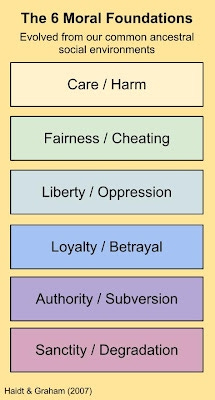If you’ve read Jonathan Haidt’s The Righteous Mind, you’ll be familiar with the following type of thought experiment:
“Julie and Mark, who are sister and brother, are traveling together in France. They are both on summer vacation from college. One night they are staying alone in a cabin near the beach. They decide that it would be interesting and fun if they tried making love. At the very least it would be a new experience for each of them. Julie is already taking birth control pills, but Mark uses a condom too, just to be safe. They both enjoy it, but they decide not to do it again. They keep that night as a special secret between them, which makes them feel even closer to each other. So what do you think about this? Was it wrong for them to have sex?”
This type of moral vignette is a central pillar in Haidt’s model of morality, known as Moral Foundations Theory. Haidt uses these “harmless wrongs” to tap into the moral mind. At least he thinks so, anyway. He believes that moral reasoning and moral convictions are primarily driven by intuition and emotion, rather than rational reflection. He also makes the case for five or six foundations of morality (see below).
How does this relate to the incest thought experiment? Well if you own anything like a normally wired human brain, two things should happen when you read about Julie and Mark’s holiday romance. The first is that you’ll probably feel a pang of disgust upon learning about their decision to have sex. But then, once you’ve thought about it, you might be unable to specify where the harm lies. After all, no children can be born, thanks to the dual birth control. Both Julie and Mark are not only consenting adults, but very happy both before and after. And they both agree never to tell anybody or do it again, which prevents a concern that this will become a relationship and that others will suffer in someway as a result.
However, once all of these obvious harm justifications are batted away by the experimenter, most participants maintain that the act is still wrong despite not being harmful. They are “morally dumbfounded” in Haidt’s terminology. They cannot help but see the act as morally wrong, in the same way you cannot help but see the two lines below as equal even though they’re not:
Moral dumbfounding is one of the most discussed effects in contemporary moral psychology. As such, there are plenty of other “harmless wrongs” to choose from: having sex with a frozen chicken, masturbating with kittens, eating dead dogs, selling your soul, getting a plastic surgery tail, and doing performance art that involves rolling around in urine.
But are these actions really harmless? Is it really possible to simultaneously call an act immoral and harmless? I think we can make two critiques of moral dumbfounding. The first is methodological and comes courtesy of Kurt Gray and his colleagues, Chelsea Schein and Adrian Ward.
In their 2018 paper, The Theory of Dyadic Morality: Reinventing Moral Judgment by Redefining Harm, Gray et.al. write that ‘the most obvious limitation with moral dumbfounding is that it conflates objective harm with perceived harm.’
What Gray et.al. are referring to is the strange methodological decision to not take the participants seriously when they declare that a moral dumbfounding situation like consensual incest is harmful. They write:
‘We find it perplexing that scholars inspired by anthropology have failed to acknowledge these perceptions of harm. Imagine if emotion researchers claimed to have designed scenarios which were “objectively” angering or saddening and yet failed to elicit these emotions in participants. It is unlikely that such claims of “objective emotionality” would be accepted. We believe that same evidentiary standards should be used in moral psychology; if participants deny that these scenarios are harmless, then we should accept their experience as legitimate.’
They go onto to note that participants are only morally dumbfounded because they’re effectively banned from reporting the basis of their moral judgement as harm. And if you want to understand what the foundations of morality are, this isn’t exactly the wisest methodological decision. Gray et.al. give the analogy of a psychologist investigating someone who fears flying because they say it’s dangerous:
‘You could argue that flying is actually quite safe — and they might rationally agree with you — but their perceptions of danger are intuitive and therefore resistant to reason. Flying may be objectively harmless, but subjective perceptions of potential harm do legitimately cause people’s fear. Moreover, if you asked people with flight phobias to tell you why they feared flying while banning them from mentioning feelings of danger, they would be rendered dumb—but this tells us nothing deep about the causes of their fear.’
The final nail in the methodological coffin is that Gray, Schein, and Ward carried out experiments that showed perceptions of harm are higher when people are forced to respond rapidly to moral dilemmas. (The rapid response method is a way to tap intuition). Surely this contradicts the idea that harm justifications are post-hoc System 2 rationalisations?
Perhaps we can also make a second critique, one more philosophical in nature. Where Gray et.al. write that moral dumbfounding conflates objective harm with perceived harm, I think we could go one step further and say that, very often, harmless wrongs are like cold fires and squared circles: they are illogical. So what if some random normie can’t defeat the arguments of a philosophy graduate when presented with the notion that secret and consensual incest is harmless? This does nothing to suggest such a claim is true.
Let’s take a step back. I’m fairly convinced that the position known in moral philosophy as moral naturalism is correct. This is a form of moral realism which holds:
…that there are objective, mind-independent facts and properties; moral naturalists hold that these objective, mind-independent moral facts are natural facts.
In other words, all morality reduces to some set of natural facts. If you’re a utilitarian, that’s (very simplistically put) pleasure and pain. All immoral actions eventually reduce to harm whether or not we can point out where the harm lies. This does not mean we cannot be confused about such an action being harmful and it does not mean that people don’t use other language games (Haidt’s foundations) to talk about immoral deeds. But if you don’t want me to burn your Bible, you can describe it in terms of sanctity all you like, eventually we get down to the raw brute fact: you believe to do so would cause yourself or others (or perhaps even myself) harm.
It’s not hard to see how the incest vignette falls apart. It does so for the same reason pseudo-consequentialism does. The pseudo-consequentialist reply to the trolley problem is: why not push the fat man off the bridge if you get the same ends — one life lost for five saved. It’s obvious why this is a terrible reply: the pseudo-consequentialist hasn’t cashed out all of the consequences. In other words, there are very good reasons for thinking that anybody who would seriously push an innocent bystander to their death or harvest the organs of a healthy patient to save five dying ones is patently insane. The consequences are obviously not the same if I’m at risk of murder every time I go for a check-up.
Likewise, we recognise that siblings who decide to screw each other are not normal, that this lack of normality is in itself a harm because of the potential consequences. We might even declare it a form of self-harm. Why, after all, would we be prepared to take them at their word when they declare their happiness and sanity? At this point, perhaps the graduate philosopher replies: what if they had been independently evaluated by a psychiatrist?
It’s here where I believe we’re getting into the psychological realm of squared circles. Healthy incest is an oxymoron for good reasons. Any penchant for incest inculcated by something like a rogue brain mutation could spell the end for any family line or even the whole species. The awareness of such threats is programmed into us in the deepest sense possible, via the emotion of disgust, an emotion that may well be unique among humans.
Now, given what we know about healthy sibling bonds, what are the chances that two such people could in fact exist and suffer no mental distress at some later point in their lives? To even grant this possibility for the purpose of philosophical reflection could well be like saying that squared circles exist. There’s an empirical assumption here that happy consensual incest cannot be akin to self-harm, an assumption which is almost certainly unwarranted, because, by definition, mentally healthy siblings do not screw each other. If they do, then again, almost by definition, something must be wrong with them and incest is likely to make that thing worse and thus be harmful.
But let’s grant this one square circle. Let’s say we can scan Julie and Mark’s brains and see that yes, they are not just mentally sound but they are the epitome of mental-wellbeing and will continue to be so until their deaths. Unlikely, but if so it wouldn’t change the threat that such a couple’s simple existence posed. If anything, one might argue that it makes it more threatening precisely because they seem to be unaffected by something which we know should be having an effect.
Julie and Mark are essentially aliens at this point. Their very happy existence is a threat to the species, whether they tell anybody or not. Perhaps they’re carrying a mutation, which, if they have children with other people, could be passed on — a reason why you wouldn’t want to reprogram your brain to feel happiness instead of disgust for them, because the disgust circuitry is like an early warning system.
Now, obviously all of these reasons are still post-hoc justifications built atop my own disgust circuitry, they’re just fancier reasons than the participants were able to give because they hadn’t seriously reflected and studied the matter. You could try to dumbfound me and say that Julie and Mark aren’t carrying a rogue mutation, you could even tell me that they’re both infertile and thus don’t threaten the species by passing on any weird incest loving genes.
But none of those replies would extinguish the more specific claim that though Julie and Mark’s incest might be a technically harmless act (though again, that warrants empirical investigation as to whether it’s scientifically possible for such a thing to not fall under self-harm), Julie and Mark’s existence is itself harmful.
I think we can argue something similar for other moral dumbfounding vignettes, too. These behaviours are so weird that anybody who did them would rightly be viewed as a legitimate threat to either their own well-being or the collective’s, which at some point must overlap anyway.
Would you want to live next door to someone who eats dead dogs on a Friday and masturbates with kittens on Saturday afternoon? Haidt, again, might protest that you’re not living next door to them in the moral dumbfounding vignette, but such an objection is illogical in the same way a squared circle is because morality is about context and relationship regulation, we simply cannot decontextualise in the way moral dumbfounding advocates want us to.
This “decontextualisation” technique uproots actions like incest from their typical epistemic environment, say finding out a father is raping his daughter (which is the most typical form of incest), and rewrites the scenario to remove any notion of physical or emotional harm. However, when we re-contextualise such examples, there is hardly ever moral ambiguity. At most, there’s a lack of information, as in the case of the trolley problem. Ultimately, everything comes back to consequences and those consequences will always centre on harm and well-being as the two foundational axes of moral reasoning.
Why does any of this matter? It matters because people who argue that such things like gay marriage are immoral (a conservative view) or that border controls are immoral (a liberal point of view) should have to prove that such things cause harm, rather than using proxies like “loyalty, authority, sanctity, and fairness”. I agree with Haidt that such foundations offer a neat taxonomy for investigating the inner moral world, but they are not separable from harm. No harm, no foul.
If you liked this, please do subscribe. Maybe give it a share to spread the gospel of rationality. And if you want to support my work, you can do so with a paid Substack subscription or using the following methods:
https://www.patreon.com/Ideas_Sleep
BTC wallet address: 1KHB3Mq7njTGfquABcREsiywaxmDbP2NPY
And subscribe to my YouTube Channel here.
















Should you sleep with your sister?